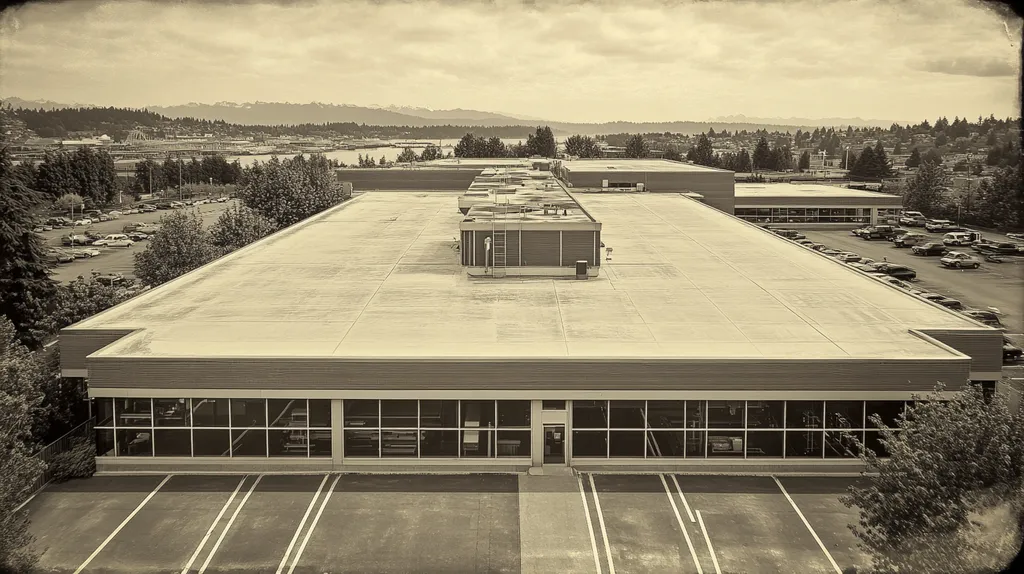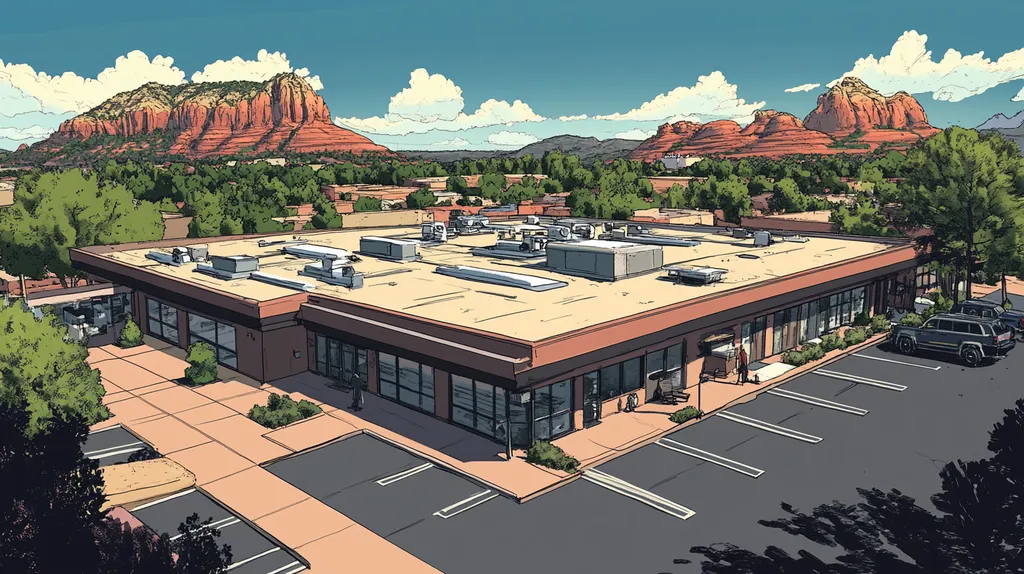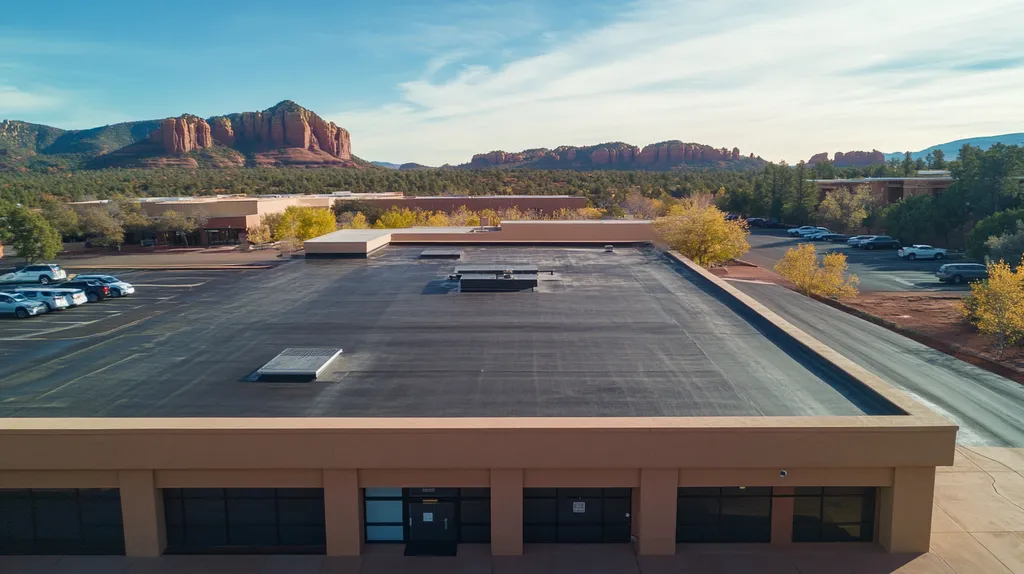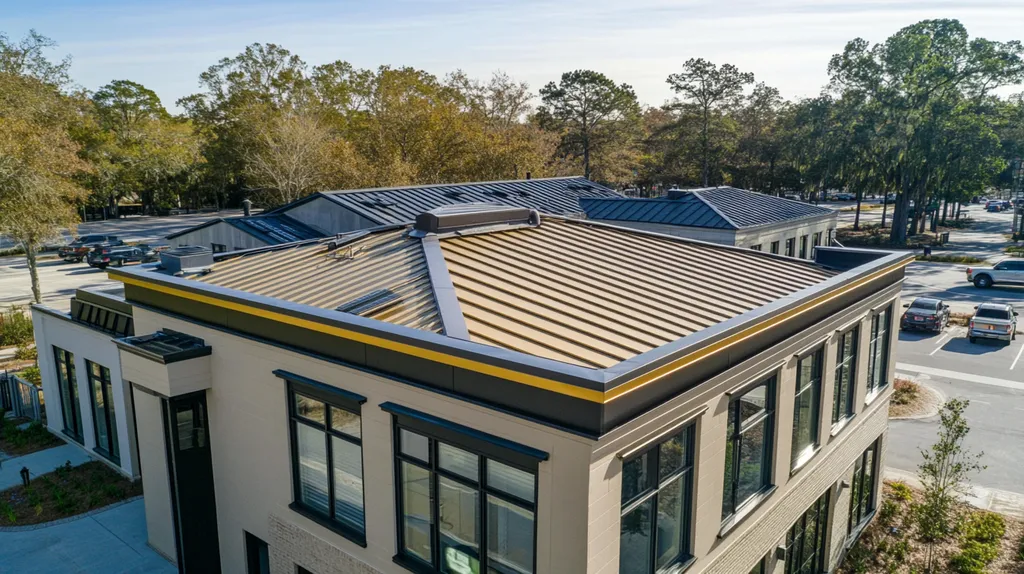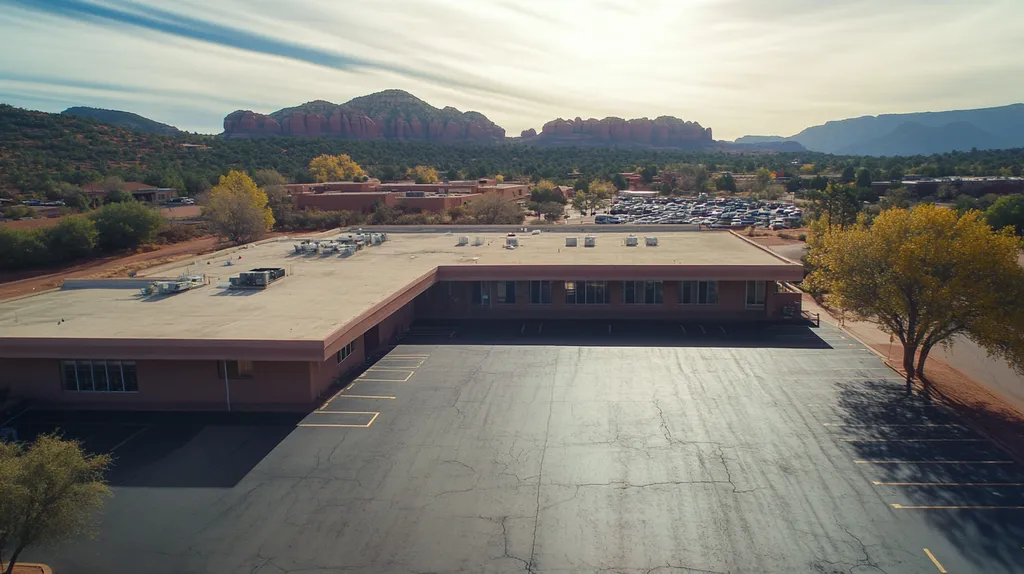Did you know that 80% of commercial roof warranty claims are denied due to improper maintenance? For facility managers and property owners, this startling statistic represents millions in potential losses each year.
Understanding and maintaining roof warranties isn’t just about paperwork – it’s about protecting your building’s most critical defensive system.
From essential terminology to common pitfalls, this comprehensive guide breaks down everything you need to know about commercial roof warranties in clear, actionable terms.
SECTION 1: THE BASICS EXPLAINED
Understanding roof warranties is essential for safeguarding commercial and industrial properties. When warranties are poorly managed, the consequences can be severe: costly repairs, unexpected downtime, and even lost revenue. A significant number of facility managers report facing sudden roofing issues that threaten the very structure of the building. This section will break down what a roof warranty truly is, why it’s crucial for your property, and how it operates to ensure lasting protection.
What It Is (In Plain Language)
A roof warranty is essentially a promise from manufacturers or contractors that they will cover specific repairs or replacements for a set period. Think of it as an insurance policy for your roofing system. Roof warranties can differ significantly in terms of coverage, conditions, and duration, making it vital to grasp these details.
There are generally two primary types of warranties: manufacturer’s warranties, which cover defects in materials, and workmanship warranties, which address installation problems. Both types play a crucial role in safeguarding a building owner’s investment.
The warranty specifics are typically outlined in a legally binding document. This means property owners must adhere to certain maintenance guidelines and reporting protocols to keep the warranty intact.
Both types of warranties provide peace of mind but require careful attention to remain valid. Thus, understanding the intricacies of these warranties is pivotal for preserving the roof’s integrity over time.
Why It Matters (To Your Building)
Roof warranties represent more than just legal forms; they are vital to the financial sustainability of a building. A properly maintained warranty acts as a shield against expensive repair costs and potential business interruptions. Should a roof start to fail, having a robust warranty can save property owners thousands of dollars.
Industry statistics reveal that a staggering 25% of commercial roofs fail prematurely due to inadequate maintenance. This figure underlines the importance of diligently following warranty terms. Overlooking these responsibilities can leave property owners vulnerable to significant financial strain.
Moreover, the management of warranties impacts building safety. A failing roof can disrupt operations and jeopardize employee safety. Therefore, adhering to warranty guidelines is essential for preserving both safety and financial health.
Ultimately, there exists a direct link between effective warranty management and the overall value of a commercial property. The condition of the roof can significantly affect insurance premiums and market value.
How It Works
To maintain a roof warranty, property owners must diligently follow the terms outlined in the warranty document. This usually involves conducting regular maintenance, hiring qualified contractors, and keeping thorough documentation of all work performed. Neglecting these steps could result in the loss of warranty coverage.
Routine inspections play a crucial role; they help spot potential problems early before they balloon into costly repairs or complete roof collapses. Many manufacturers recommend conducting inspections at least twice a year and after significant weather events.
It’s also essential that any repairs are carried out by authorized contractors to ensure compliance with warranty stipulations. Employing unapproved service providers can void the warranty altogether.
Finally, keeping meticulous records of all maintenance and inspections is vital. These documents serve as proof that the obligations have been fulfilled, which is invaluable should a claim ever need to be filed.
SECTION 2: PRACTICAL APPLICATIONS
Grasping how to effectively maintain industrial roof warranties is not just a good idea; it’s a necessity for property owners and facility managers. Alarmingly, research shows that failure to uphold maintenance standards can void as much as 30% of existing warranties. The risks associated with neglecting these duties can lead to hefty repair bills and interruptions to day-to-day operations. This section delves into the common uses of warranties, the moments when extra care is indispensable, and how roofs interact with other building systems to help facility leaders protect their investments.
Common Uses & Examples
Roof warranties play a pivotal role in safeguarding against various damage types. Manufacturers usually provide coverage for issues such as leaks, ponding water, and material defects. For example, a typical warranty may cover leaks arising from faulty installation for an impressive 20 years.
Another significant aspect is the warranty’s demand for routine inspections. Failing to carry out these checks can fast-track the risk of voiding the warranty. Regular inspections are your first line of defense, helping to identify issues before they morph into expensive repairs.
Some warranties extend their coverage to include integral components like flashing and drainage systems, making their proper functioning crucial. Facility managers must grasp these nuances to ensure they maintain comprehensive protection for the entire roofing system.
By leveraging warranties accurately, facility managers can not only extend the life of the roof but also adhere to warranty guidelines that preserve their investment.
When You Need It Most
Knowing when to leverage warranty protections is crucial for asset preservation. Specific events, like severe weather or heavy snowfall, can put roofs in peril. Conducting inspections post-event can substantiate warranty claims if any damage is discovered.
The age of the roofing system also affects maintenance urgency. As roofs mature, their vulnerability increases, turning timely check-ups into an essential priority.
Moreover, seasonal maintenance often flies under the radar but is crucial for warranty compliance. Keeping consistent maintenance schedules and being diligent about documentation can bolster any claims made under the warranty.
Responding to issues promptly can save you from steep repair costs and ensure roofs perform optimally throughout their warranty duration.
Interactions With Other Systems
The roof isn’t just a standalone entity; it interacts closely with various building systems, impacting warranty compliance. For instance, roofing systems are often entwined with HVAC and drainage systems. A failure in one system can jeopardize the warranty status of the roof.
Additionally, rooftop equipment like HVAC units must be installed and maintained correctly. Ignoring these protocols can lead to roof damage that falls outside warranty coverage, leaving property owners in a lurch.
It’s equally crucial to consider how accessibility and any modifications to the roof may impact warranties. Adding new equipment or making architectural alterations can inadvertently compromise the roof’s integrity.
By effectively managing these interconnected systems, property owners can maintain compliance with warranties and ensure the longevity of their overall investment.
SECTION 3: KEY TERMINOLOGY DECODED
Navigating the world of roof warranties can feel like stumbling through a maze of complex terms and phrases. Misunderstanding key terminology can lead to financial headaches and potentially void your warranty. For instance, simply not grasping maintenance obligations could result in costly repairs down the line, or even a shorter roof lifespan. This section breaks down essential terms, translates the industry’s jargon, and simplifies measurements, empowering property owners and facility managers to make informed decisions with confidence.
Essential Terms Explained
When delving into roof warranties, certain terms are pivotal. Take “membrane,” for example; it’s the waterproof layer that serves as the first line of defense against leaks. Then there’s the “substrate,” which is the supporting material beneath the membrane. Knowing these terms helps clarify what the warranty covers.
Another important term is “installers’ certification.” This means the roofing contractor is qualified to install under the warranty conditions. It’s essential for property owners to verify these certifications to protect their investment.
Lastly, “maintenance requirements” describe the actions property owners need to take to keep their warranty active. Regular inspections, timely repairs, and proper cleaning are crucial steps in safeguarding against warranty claims being denied.
Industry Jargon Translated
The roofing world is rife with terms that can easily bewilder. Consider “ponding”—this describes water pooling on flat roofs, which can lead to serious deterioration and threaten warranty validity if left unchecked. Knowing such specifics can help maintain a roof’s longevity.
Another term to know is “thermal imaging,” a technology that identifies problems in roof insulation before they escalate. Routine checks using thermal imaging can preserve warranty coverage while catching issues early.
Finally, “flashings” are materials placed at roof seams and transitions to protect against moisture intrusion. Understanding how these components work is vital for effective inspections and ongoing maintenance.
Measurement & Units Simplified
Precise measurements are indispensable for determining roof health and maintenance needs. Typically, roofs are measured in square feet, while materials are often sold by the square (100 square feet). Familiarity with these units helps property owners buy the right quantities for repairs or replacements.
Another key measurement is “slope,” which indicates the roof’s angle affecting drainage. It’s expressed as a ratio, like 4:12, meaning the roof rises 4 inches for every 12 horizontal inches. This detail is crucial for selecting appropriate materials and installation techniques for effective water runoff.
Lastly, roofing materials come with a service life defined in years, often specified in warranties. Understanding the lifespan of various materials can aid property owners in budgeting for future replacements, ensuring they remain compliant with warranty terms.
SECTION 4: DECISION FACTORS
Making smart choices about industrial roof warranties is a game-changer for property owners and facility managers. Shoddy decisions can result in expensive repairs or premature replacements, putting a dent in budgets. Alarmingly, many commercial roofs fall short of their expected lifespans due to ignored warranty terms and lackluster maintenance. Here, we’ll explore essential factors influencing roofing decisions: cost considerations, performance trade-offs, and the vital aspects of lifespan and durability.
Cost Considerations
Understanding the financial ramifications of roofing choices is critical for maintaining a balanced budget. While a lower initial cost might seem appealing, it often leads to larger expenses down the line. For example, selecting cheaper roofing materials may sacrifice durability, resulting in more frequent repairs.
On the flip side, investing in high-quality roofing materials can yield long-lasting performance, ultimately saving money on repairs over time. A thorough cost analysis should look beyond immediate expenses and weigh potential future liabilities.
Property owners must also factor in costs associated with following warranty guidelines. Neglecting specific maintenance requirements can void warranties and lead to serious financial losses.
A well-thought-out budget should address both current costs and long-term financial health to ensure the chosen roofing solution offers lasting value and functionality.
Performance Trade-offs
Choosing roofing materials often involves navigating a maze of performance trade-offs. Properties with unique requirements may need materials that excel in certain features, such as energy efficiency or resistance to extreme weather. These characteristics can drastically affect long-term satisfaction with the roof.
For instance, a thermoplastic polyolefin (TPO) roof can enhance energy efficiency by reflecting sunlight, thus lowering cooling costs. However, it might lack puncture resistance compared to sturdier materials, risking damage during heavy foot traffic.
Understanding these trade-offs helps property managers align roofing choices with their specific operational needs. Careful comparisons of various roofing materials based on performance metrics are crucial for informed decision-making.
In summary, weighing the benefits against potential drawbacks is essential. This balance ensures the chosen roofing solution functions effectively throughout its entire warranty period.
Lifespan & Durability Factors
The expected lifespan and durability of roofing materials are vital elements connected to warranty compliance. Roofing systems vary broadly in their anticipated service lives, making this an important consideration. For example, single-ply membranes might last 20 to 30 years, while modified bitumen systems may need replacement sooner.
Factors affecting durability include weather resistance, UV protection, and physical wear. Roofs in harsher climates can deteriorate faster unless crafted for those conditions, emphasizing the importance of selecting the right roofing type for the local environment.
Additionally, a roof’s durability influences maintenance frequency and expenses. A robust roof provides peace of mind by lowering operational concerns, while a less durable option might require more frequent upkeep.
Ultimately, understanding the relationship between lifespan and durability empowers property owners to select roofs that not only satisfy immediate needs but also endure over time, thereby protecting their investments.
SECTION 5: COMMON CHALLENGES
Maintaining industrial roof warranties is no walk in the park! For property owners and facility managers, the stakes are high. A staggering 80% of warranty claims are denied due to improper maintenance, which can lead to financial losses and safety concerns. Identifying common hurdles and taking action early is critical for ensuring roofing longevity and warranty compliance.
Frequent Problems & Solutions
One of the most common pitfalls is skipping routine inspections. Ignoring these regular check-ups can allow minor issues to snowball into serious damage. Establishing a set inspection schedule—from biannual checks to after severe weather—can significantly curb this problem.
Documentation is another stumbling block. Without keeping detailed records of maintenance tasks, property owners may find their warranty claims rejected. Maintaining logs of all inspections and repairs demonstrates compliance with warranty stipulations and ensures you’re covered when it matters.
Water intrusion often starts with missing or damaged flashings, resulting in costly repairs after storms. Making it a habit to routinely check and promptly fix flashings can prevent significant water damage, enhancing roof longevity.
Finally, remember that using unapproved roofing materials can void warranties faster than you can say “roofing crisis.” Always consult warranty guidelines to ensure that any materials and repair methods meet manufacturer requirements.
Warning Signs To Watch For
Catching roofing issues early is essential for keeping warranties intact. One major warning sign is visible water stains appearing on ceilings or walls, which may signal leaks in the roof. Immediate investigation is crucial, as this can prevent further damage.
Another red flag is rust or corrosion around metal components. This can indicate poor drainage, which could lead to premature aging. Staying alert to these signs can save property owners from costly repairs down the line.
Blistering or bubbling on the roof surface? That’s another concerning issue! This often suggests moisture is trapped beneath the membrane, threatening the overall integrity of the roof.
Don’t forget about your energy bills. A sudden spike might hint at insulation or ventilation problems linked to roof damage. Keeping an eye on energy costs can serve as an early warning system for potential warranty-relevant issues.
Preventative Approaches
Proactive maintenance is the key to making roof challenges manageable. Establishing a routine maintenance schedule, including semi-annual inspections, helps catch small issues before they escalate into bigger repairs.
Investing in high-quality materials during repairs not only extends the roof’s lifespan but also keeps warranty compliance in check. Opting for products that meet or exceed manufacturer specifications guards against future deterioration.
Training facility management staff to recognize early warning signs empowers them to take swift action. Continuous education about roofing systems promotes better decision-making, ensuring effective maintenance and repairs.
Finally, forming a solid partnership with a qualified commercial roofing contractor can provide invaluable support. Regular consultations can keep property owners informed about best practices, enhancing their ability to maintain warranties effectively.
SECTION 6: NEXT STEPS & RESOURCES
Neglecting industrial roof warranties can turn into a costly gamble for property owners and facility managers. A staggering 30% of warranty claims face denial primarily due to insufficient maintenance or inadequate documentation. Understanding the next steps can safeguard the roof’s integrity and help keep warranties intact, setting the stage for long-term protection.
Questions To Ask Providers
Engaging with roofing providers can feel overwhelming, but asking the right questions can clarify warranty conditions. Start by inquiring about specific maintenance responsibilities and the documentation necessary to uphold the warranty. Knowing who is in charge of inspections will prevent unexpected costs down the road.
It’s essential to discuss the warranty’s duration and coverage limits. Don’t hesitate to ask about any exclusions or conditions that may affect future claims. This foundational knowledge helps property owners make informed decisions that align with roof care.
Furthermore, asking for examples of past warranty claims handled by the provider is invaluable. A proven track record can offer reassurance. Providers who present references or case studies demonstrate confidence in their services and might save you headaches later.
Finally, clarify what is expected in terms of materials and workmanship. Knowing the quality standards necessary for compliance will unify decision-making processes around effective warranty management.
Industry Standards & Guidelines
Utilizing established industry standards is vital for maintaining roof warranties. The National Roofing Contractors Association (NRCA) lays out critical guidelines that every property owner should familiarize themselves with, including maintenance schedules and inspection protocols.
Understanding the American Society for Testing and Materials (ASTM) standards can further minimize risks associated with roofing materials. These benchmarks provide crucial metrics on durability and performance, ensuring that both repairs and replacements meet warranty requirements.
Reviewing these standards also aids in identifying qualified roofing professionals. When selecting contractors, look for those who adhere to these industry benchmarks; this can significantly impact warranty claims and the overall longevity of the roof.
Staying up-to-date with evolving industry regulations is equally important. Participating in workshops or webinars hosted by roofing associations connects property owners to the latest best practices for effective warranty maintenance.
Further Learning Simplified
Property owners keen on becoming warranty experts should explore various learning resources available. Online courses filed under respected roofing organizations can provide invaluable insights into warranty management and compliance. These courses simplify complex concepts, presenting them in an accessible way.
Webinars and online seminars are excellent for ongoing education. Industry experts share practical tips on warranty maintenance, and attending these events opens networking opportunities with fellow professionals.
Additionally, keeping up with industry publications and blogs that focus on roofing trends and warranty matters can be enormously beneficial. Regular engagement with this content empowers stakeholders to make proactive decisions regarding roof care.
Lastly, communities or forums dedicated to commercial roofing are fantastic resources. Engaging with peers allows property owners to share tips, troubleshoot issues, and discuss compliance concerns in real-time—all pivotal for effective warranty management.
The Bottom Line
With 80% of warranty claims being denied due to improper maintenance, the stakes for managing industrial roof warranties couldn’t be higher.
Property owners and facility managers must take a proactive approach to protect their substantial roofing investments.
Regular inspections, meticulous documentation, and adherence to manufacturer specifications aren’t just good practices—they’re essential safeguards against potentially catastrophic financial losses.
By understanding warranty terms, maintaining compliance, and partnering with qualified contractors, facility leaders can ensure their roofs deliver maximum performance throughout their expected lifespans.
The difference between a valid warranty and a void one often comes down to consistent, documented maintenance and swift response to emerging issues.
FREQUENTLY ASKED QUESTIONS
Q. What is a commercial roof warranty?
A. A commercial roof warranty is essentially a promise from manufacturers or contractors to cover specific repairs or replacements for a certain period. These warranties come in various types and detail coverage, conditions, and durations, making it essential for property owners to fully understand the ins and outs to protect their investment effectively.
Q. How can I maintain my industrial roof warranty?
A. Maintaining an industrial roof warranty requires regular inspections and compliance with maintenance standards outlined in the warranty document. Regular upkeep helps prevent costly repairs and ensures compliance, while thorough documentation of maintenance activities can bolster any claims made if issues arise, protecting your investment over time.
Q. What are key terms in commercial roof warranties?
A. Key terms include “membrane,” which refers to the waterproof layer, and “substrate,” the supporting material beneath it. Understanding terms such as “installers’ certification” ensures that you’re hiring qualified contractors, while “maintenance requirements” describe the actions needed to keep your warranty active and protect against potential future claims.
Q. How do cost considerations affect my commercial roof choice?
A. Cost considerations are crucial when choosing a roofing solution. While lower initial costs may seem appealing, they can lead to higher expenses down the line due to more frequent repairs. Investing in quality materials may offer long-term savings and durability, so it’s important to consider both current and future costs before deciding.
Q. What are common challenges in maintaining industrial roof warranties?
A. Common challenges include skipping routine inspections, which can lead to significant issues going unnoticed. Additionally, failing to document maintenance properly can result in denied warranty claims. Monitoring for warning signs like water stains or rust is also key to preventing future problems and ensuring compliance with warranty agreements.
Q. What steps should I take next regarding my roof warranties?
A. Next steps include asking your roofing provider about specific maintenance responsibilities and documentation requirements. Familiarize yourself with industry standards and guidelines to ensure compliance, while considering further learning through courses or resources that simplify warranty management concepts and best practices.
Q. How can I ensure my commercial roof warranty claims are not denied?
A. To avoid denial of claims, maintain a consistent inspection schedule and document all maintenance activities thoroughly. Ensuring compliance with the maintenance requirements outlined in your warranty is crucial. Using authorized contractors for any repairs and keeping detailed records can significantly improve your chances of successful warranty claims.


